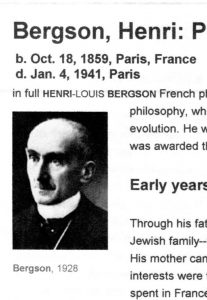☞ “Those who understand jokes are many; those who understand true laughter are few.” Hakuin Ekaku 1686-1768
 ☞ As readers may already know, an honored paper pappy of the past at 3T is Democritus, the early Greek thinker who became known in his later years as the “laughing philosopher.” Not the reputation usually conferred upon a philosopher, especially a serious one who first perceived the composition of the material world down to the atom. With such perception in his later years, he was prompted to bust out laughing at most things observed on the street. As a Macedonian businessman who’d traveled around the Mediterranean, his experience with the world must have built up plenty of ammunition for amusement at what was then a world even possibly goofier than our own. In his world, slavery, for example, was a fact of life. Combat in the field was face-to-face. Christian charity was yet to come, and democracy only worked out for a little while. So lesser folks had only to rely on the patronage of the rich and powerful. Women were bargained in marriage, and some were poisoners. Plenty of pretension, plenty of pride to go around, and plenty of posers to laugh at.
☞ As readers may already know, an honored paper pappy of the past at 3T is Democritus, the early Greek thinker who became known in his later years as the “laughing philosopher.” Not the reputation usually conferred upon a philosopher, especially a serious one who first perceived the composition of the material world down to the atom. With such perception in his later years, he was prompted to bust out laughing at most things observed on the street. As a Macedonian businessman who’d traveled around the Mediterranean, his experience with the world must have built up plenty of ammunition for amusement at what was then a world even possibly goofier than our own. In his world, slavery, for example, was a fact of life. Combat in the field was face-to-face. Christian charity was yet to come, and democracy only worked out for a little while. So lesser folks had only to rely on the patronage of the rich and powerful. Women were bargained in marriage, and some were poisoners. Plenty of pretension, plenty of pride to go around, and plenty of posers to laugh at.
 ☞ When idiocies are as common as sunrise, laughter is an understandable response. But what actually makes us laugh? What are the targets? According to the French philosopher Henri Bergson, we laugh at whatever situation or statement creates inanimate behavior in a person: “the mechanical encrusted on the living.” Tragic figures need pity, so they must become more human in our eyes for that to happen. But comic characters need distance, which reduces their humanity to the mechanical. When folks start behaving in a predictably repetitive way, they are reduced to some kind of slapstick role, robotic, mechanistic (Bergson originated the word) stick figures.
☞ When idiocies are as common as sunrise, laughter is an understandable response. But what actually makes us laugh? What are the targets? According to the French philosopher Henri Bergson, we laugh at whatever situation or statement creates inanimate behavior in a person: “the mechanical encrusted on the living.” Tragic figures need pity, so they must become more human in our eyes for that to happen. But comic characters need distance, which reduces their humanity to the mechanical. When folks start behaving in a predictably repetitive way, they are reduced to some kind of slapstick role, robotic, mechanistic (Bergson originated the word) stick figures.
☞ In fact slapstick comedy is a good rule of thumb. Clownish characters seen in the choppy mechanical movement of early films (appearing around the same turn-of-the-century era as Bergson’s theory of laughter) the human image is reduced. The inanimate, the robotic renders the human figure less sympathetic. Add to that the pretension of a character assuming a stately form, like a robot with manners. The classic example would be the pretentious form of a stately man in formal dress and top hat slipping on a banana peel.
 ☞ Jerry Lewis was well aware of this principle by becoming a marionette— in his case a spastic nine year-old. For this he was idolized by the French. Lionized by New Wave directors as a role model, stories exist of Lewis’ dealing with those who tried to make more of his comedy than… well, comedy. One incident related by British journalist John Walsh in The Independent (June, 97) tells of a pretentious French fan, steeped in the “philosophy” of Nouvelle Vague cinema, actually meeting Jerry Lewis and butting up against the comedian’s simple formula for funny: “Many stories are told of the chronic mis-match between Lewis’s more pretentious fans and Lewis’s own unpretentious deflations. Such as the symposium in Paris when he was congratulated by a voluble cineaste for his visual jokes with fat ladies in The Bellboy. ‘Not only is it a trenchant satire on Western consumerism,’ said the fan, ‘it’s also a swinging attack on American matriarchy and the ethos of…’”
☞ Jerry Lewis was well aware of this principle by becoming a marionette— in his case a spastic nine year-old. For this he was idolized by the French. Lionized by New Wave directors as a role model, stories exist of Lewis’ dealing with those who tried to make more of his comedy than… well, comedy. One incident related by British journalist John Walsh in The Independent (June, 97) tells of a pretentious French fan, steeped in the “philosophy” of Nouvelle Vague cinema, actually meeting Jerry Lewis and butting up against the comedian’s simple formula for funny: “Many stories are told of the chronic mis-match between Lewis’s more pretentious fans and Lewis’s own unpretentious deflations. Such as the symposium in Paris when he was congratulated by a voluble cineaste for his visual jokes with fat ladies in The Bellboy. ‘Not only is it a trenchant satire on Western consumerism,’ said the fan, ‘it’s also a swinging attack on American matriarchy and the ethos of…’”
And how did Lewis manage to ward off that Franco fop. Lewis merely cut him off, replying shortly: “Fat women walk funny.”
Apologies to fat women, but Lewis was actually following Bergson theory that a distorted body enters the realm of the mechanically ungraceful (“the mechanical encrusted on the living”). If the woman walking into the hotel lobby were slim and graceful, she would not be waddling like a sea cow, and therefore no reason to laugh— unless…
☞ Unless she, the slim graceful woman like, opened her mouth and, like, spoke in a squeaky voice full of California valley girl upspeak. That’s the motorized manner of, like, speaking where the rear R of a word is slurred, like rememburrr. And every sentence ends with, like, the voice going up like you’re asking a question? But there is no, like, question? That would put emphasis on the second stage of, like, laughter: like vocal expression.
The mechanical in speech— and the dizzy thought behind it— reflects in the fashionistic comment of Jerry Lewis’ French fan, who was ready to build an entire philosophy out of a fat woman walking. Lewis’ riposte gave a curt example of truth cutting through shit.
☞ Now consider the Jerry Lewis jarghead film fan as a newscaster. Then we are closer to sharing the view of Democritus. Watching the news as it is presented today offers an excellent example of our very ordinary mundane world, and the daily joke it provides for laughter. News presentation, on Cyclops TV especially, introduces the coup de gras of comedy:
☞ repetition, repetition, repetition.
Mechanical repetitions make up the stock-in-trade of the comic. Whenever the chronic curmudgeon W.C. Fields repeated a tag line— “Anybody who hates dogs and kids can’t be all bad”— there was instant recognition and mirth to follow. The running gag in movies is another easy example. Before television (BTV) films preceding a movie house feature made short stabs at comic entertainment. The usual fare featured a “running gag” with recurrent jump-cuts: a guy trying to start an uncooperative outboard motor, or a fisherman constantly getting his casting line snagged, and the audience was supposed to find that frustration funny.
☞ In TV sitcoms, which character is not subject to a laugh with repetition of a recognizable trait or tag line? Who’s stingy? Who’s sexually frustrated? All grist for the humor mill. And not only dialogue, but laughter itself becomes mechanical. Canned laughter is a joke unto itself. It renders the audience in a state of robotic response triggered not by the funny bit but a “cue” for laughter.
(To help spot the running gag in contemporary events, a previous Trying Times worx The Berger Jockey Club played with the idea of how a national security adviser had to hide certain documents by spiriting them out of security lockup on his person, including his underwear, while Hillary Clinton merely had to smash hard drives. So the medium is really the message, and the medium is repetition. News, if not history itself, is the same running gag, like the jump cut of the unfortunate slob who just can’t get his outboard motor to start, or the way America just can’t seem to get justice to run tip top.)
☞ Today what passes for news is an amalgamation of talking heads, Cyclops framed, and “analyzing” current “talking points” about some “issue” thing that someone else is claimed to have said— and it’s all repeated. It’s all repeated sometimes down to the sentence structure itself: sentences starting with the same phrase. “The fact is…” The fact is..” All sounding like a convention of gossips chattering over the national neighborhood fence, or maybe more like a party line from Central Committee. Farce news shows up when listeners and viewers are treated to a montage of newscasters’ repeating these scripted talking points. Supposedly started by the Rush Limbaugh show, more news commentators have taken to giving their audience the daily montages of different news people taking up the same talking points, pontificating verbatim the same platitude in endless repetition— like scripted news itself as a running gag.
Listening to montages of verbiage garbage enforces a very strong suspicion that artificial intelligence is already here, and no one even had to operate on skulls to do it. And that’s when the listener reaches that threatening moment and faces the danger of being gripped in the throes of a Democritic seizure of laughter. The only antidote is the realization that propaganda is serious. It’s not likely that a country was lost by laughing at a comedian.
☞ So this awareness of daily foolery begs a question: What can an individual person deploy in self-defense against such a magnitude, such a groundswell of flimflammery and foofoofery? It seems as though a motto is needed, a formula, a banner statement to ward off the mad repetition of silliness. Let’s seek an utterance designed to dispel the spell of idiocy cast before thee.
☞ For a while, a response delivered by the Zen master Hakuin worked as an all-purpose charm for dismissing the onslaught of revolving dopes. Hakuin’s defense was a three-word question told in a tale of misunderstanding: Is That So?
There was once a pretty girl whose parents were small merchants in their village. She was a dutiful daughter, helping around the home and in the shop. It was thus sudden and without warning when her parents discovered she was with child. If they were not angry enough by this discovery, their anger grew even more when she refused to confess who was responsible. She only held tearful silence. She held it as long as she could. Yet, after much harassment, the distraught young woman at last named Hakuin. She had named as the father the monk Hakuin who lived in a humble shack near the temple.
This was the same Zen master who was praised as one living the purest of lives. So, as soon as the child was born, he was brought straightaway to Hakuin. Not to be put off by Hakuin’s fine reputation, the parents hastened through the village to hurl their sharp accusations. Fiercely, indignantly, they castigated him at his doorstep as one who presented a pure character to the public eye while secretly acting with utterly base motive, and thrust the child at him. But Hakuin seemed unaffected. “Is that so?” That is all Hakuin said: “Is that so?”
By this time the master had lost his once-stainless reputation. Despite his losses, however, he took excellent care of the child. Hakuin’s begging bowl became devoted to nourishing the infant. It made a daily circuit of neighbors’ houses filled with milk or anything else the little one might need. A complete cycle of seasons passed. With the cherry trees once again in bloom, the girl-mother could stand it no longer. She told her parents the father of the child was in truth a young man who worked at the fish market.
The parents went at once to Hakuin to ask his forgiveness. The mother of the girl stood just outside the shabby door of Hakuin’s hut. As she spoke her lengthy apology, she peeked greedily at the grandchild within who was at the time impervious to all and drooling over a bean cake. The father was surprised to see how well the infant looked. Instead of the thin waif he had expected, here was a healthy youngster on the verge of standing by himself. At last, both grandparents forged ahead and asked if they could have the boy back. Hakuin was willing. He offered him up at once. And in yielding up the child, Hakuin had only one thing to say:
“Is that so?”
☞ Although this is an eighteenth century tale of Hakuin Ekaku, patriach of Zen Buddhism, it is still full- blown soap opera material that could be scripted today. It offers the usual mundane spectrum of human egoism, a wide target in itself. In her sorry circumstance the pregnant daughter names the man most unlikely to be responsible, perhaps a projection of newly-found power which deludes her into believing she could even lure the famously virtuous monk. The parents are accomplices in this fantasy, perhaps flattered by the same erroneous notion. They seem also, as part of the naturally sinful community, quite ready to believe in the monk’s fallibility. This willingness to believe in Hakuin’s sin is evident by their swift indignation. One character who doesn’t even appear, the young father, suggests fear of the censure which Hakuin sympathetically endures. Overall, there is the communal voice passing judgment by hearsay. The voice of gossip makes its righteous call, which villages do best. This panorama of human foible underscores the irony— the Zen perspective— of the monk’s only remark through the circumstance, which is at once the most mundane of responses while also the most searing of rebukes:
“Yes,” according to how people behave, “it is quite so.”
☞ So Hakuin’s defense served for quite a while in warding off the nonsense endured on a daily basis, Three little words to set up against what W.B. Yeats referred to as “the day’s war with every knave and dolt.” Some fan eliciting praise, say, for a pop group singing a one-line repetition song with two-chord changes would still elicit Hakuin’s response to such jarghead praise: “Is that so?”
☞ Hakuin’s rejoinder served until I encountered another I liked better. On an excursion with a friend to Death Valley, I heard another expression which stuck with me since. And it was out of the mouth of a denizen of the desert who was pumping gas.
☞ My friend and I wanted to enter Death Valley by an exterior route through Titus Canyon. A rugged route the guidebook warned, and should not be traveled in inclement weather. Well, it was an overcast day. First we needed gas in the town of Beatty, Nevada, out the east gate of Death Valley. Driving there we passed the entrance to Titus Canyon which was still open. Therefore, the question was still open: to go or not to go.
While the station attendant in Beatty, a crusty fellow in an equally crusty army surplus jacket, was pumping gas into our rig, my friend asked him if he thought it was alright to go that day into Titus Canyon.
☞ His answer was as short as Jerry Lewis’ reply to the French film fop: “You can. I wouldn’t.”
 The decision was yet prolonged until we rode back toward the valley and saw that the park service had closed the gate to Titus Canyon. So the decision was made for us. And later the next day, when we did go into the canyon, we saw why it had been closed. In many places the road was a mere suggestion of a narrow track over clay soil that would have turned slippery in rain, and the exposure off the road was way way down. The gas station guy could have hinted at this. He could have told us how the road went through narrow canyons and even actual tunnels. Instant rain
The decision was yet prolonged until we rode back toward the valley and saw that the park service had closed the gate to Titus Canyon. So the decision was made for us. And later the next day, when we did go into the canyon, we saw why it had been closed. In many places the road was a mere suggestion of a narrow track over clay soil that would have turned slippery in rain, and the exposure off the road was way way down. The gas station guy could have hinted at this. He could have told us how the road went through narrow canyons and even actual tunnels. Instant rain  would easily siphon into a wall of shooting water that could have turned our vehicle into a submarine.
would easily siphon into a wall of shooting water that could have turned our vehicle into a submarine.
But he didn’t. All he gave in his laconic way to two college boys inexperienced in the treachery of the desert was a simple statement: “You can; I wouldn’t.”
That rejoinder has served in many ways, and still does. Try it out.
☞ “I believe that there’s great art in the making.”
You can; I wouldn’t.
☞ “I think I’ll go to college to gain knowledge and broaden my horizon.”
You can: I wouldn’t.
☞ “I want to vote for a woman, even if her entire political career has been immersed in suspiciously criminal cases, including murder.”
You can; I wouldn’t.
See how well it works. It keeps comment to a minimum. Four words which sound so democratic. The “you” has a perfect right to opinion, but the “I” counters it with just a slight hint of objection in response…
☞ “I agree with the investigation that a savvy businessman billionaire would sell out his whole presidential destiny to a funky agglomeration of Russian thieves.”
You can; I wouldn’t.
☞ “I’m going to have my dick lopped off so I can be a woman and worry about how my hair looks.”
You can; I wouldn’t.
It’s such a neat setup. Just takes one more word than Hakuin’s three-word question. But those mere four words reflect the spirit of democracy in which every person is allowed his or her conviction— no matter how dopey— while at the same time giving a response slightly tinged with a position and a judgment. Four little words to set up as a bulwark against the day’s war with every knave and dolt.
☞ If you doubt this, you can. I wouldn’t.
JoCo
